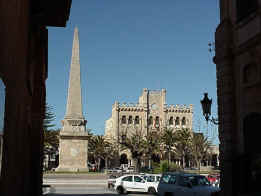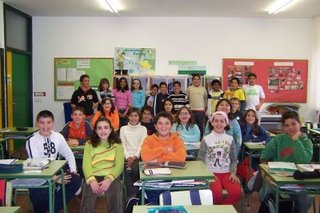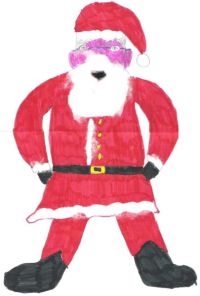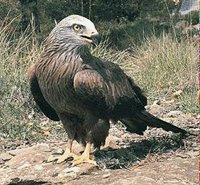Thursday, May 17, 2007
MÀSCARES DE GUIX


Hem fet màscares de guix, primer ens vam posar en parelles i després un de la parella li va posar a l’altre crema a la cara i li va posar benes de guix amb aigua a la cara i li va fer la forma de la cara. Quan estava la màscara un poc eixuta li va llevar de la cara i cadascú va pintar la seva quan estava ben eixuta.
LLIBRETA DE PUNT DE CREUETA

Per fi hem acabat el punt de creueta. Ens ha duit molta feina, des de principi d´any li hem dedicat una hora setmanal, però ara que ja hem acabat esteim molt contents. Hem fet la bandera d’Anglaterra, la de Polònia, la d’Espanya i la d’Itàlia.
Thursday, February 22, 2007
Ferreries

Hello friends:
We are the students of Year 4 of Castell de Santa Àgueda Primary School of Ferreries (Menorca). We send you this letter to tell you how was and how is Ferreries.
Ferreries was founded in 1303, when king James II built a church: Sant Bartomeu’s Church.
Some houses were built next to the church. Ferreries was very small, four streets, and there were 40 people living there.
The oldest streets in Ferreries are the streets near the church.
Many years ago, people worked in farms: look after animals and plants. On Sundays people who lived in farms came to pray to the church (town centre) and they also sold the food they made.
Many years ago, people were poor.
In the XVIII century Ferreries grew more. From 1960 Ferreries grew more and more.
Nowadays, in Ferreries there are some factories and a very important tourist resort: Cala Galdana.
We hope you have enjoyed.
See you soon.
Students of Year 4.
Ciutadella

Hello friends:
We are Year 4 class. We are going to tell how is Ciutadella .
Ciutadella has got a big municipal area. It was the former capital in Menorca, and many years ago it was surrounded by walls. In the old part of the town we can see buildings that they remind us the history of a small town: the cathedral (XIV), small palaces, narrow streets…
In Es Born Square there is a statue. In 1558 people who lived in Ciutadella defended their religion from the Turks. Many people from Menorca died and other people went to Turkey.
The Town Hall in Ciutadella is set at the top of a cliff next to the port of Ciutadella. In this port you can see fishermen boats, and in summer boats for tourists.
The city has become bigger: building new houses…
People work in tourism, agriculture (farms), shoe factories, jewellery factories and services.
Ciutadella is very proud of its fiestas, in June: Saint John.
In Ciutadella there are two museums: a municipal museum (Bastió de Sa Font) and the church museum, at the seminar.
The bishop of Menorca lives in Ciutadella.
See you soon, we hope you like this letter.
Students of Year 4
Thursday, January 25, 2007
Premi de glosa Josep Vivó - Prize about poems

In December students of year 6 wrote some short poems (4 and 6 verses) called “cançonetes” and “gloses”…about where we live, Minorca: towns, animals, plants...
We sent the poems to the C.I.M. (Council of Minorca) and we won a prize.
Last Friday evening (20th January) some students went to Es Castell to receive the prize.
Wednesday, December 20, 2006
Cuscussó

Una companya de l'escola, na Joana, em va passar la recepta del cuscussó: dolç que es fa a Ferreries quan arriben les festes de Nadal.
INGREDIENTS
500 grams de pa ratllat blanc o integral, sense sal.
500 grams d’ametlla ratllada.
500 o 400 grams de sucre.
150 g de seu o d’oli d’oliva suau.
1 got d’aigua o 2 dits d’aigua (segons si es vol fer com un pa o no).
Llimona ratllada.
Pinyons, panses, fruita confitada, albercocs...
1. Pelar ses ametlles i ratllar-les.
2. Ratllar es pa i torrar-lo un poquet.
3. Torrar els pinyons.
4. Posar s’oli o es seu, s’aigua, llimona, pinyons, panses... al foc fins que sa sucre es fongui.
5. Afegir-hi s’ametlla i després es pa.
6. Remenar un poquet que quedi tot mesclat i apagar es foc.
A colleague, Joana, gave me the recipe of "cuscussó". This is a traditional Christmas dessert we make and eat in Ferreries.
INGREDIENTS
500 g bread.
500 g almonds.
500 or 400 g sugar.
150 g butter or olive oil.
1 glass of water.
Lemon peel.
Pine-nuts, raisins, fruit...
1. Peel the almonds and cut them in small pieces.
2. Cut and chop the bread and toast.
3. Toast the pine-nuts.
4. Add the oil or the butter, the water, lemon peel (chop), pine-nuts, raisins... until the sugar is melted.
5. Add the almonds and then add the bread.
6. Stir together.
Preparant el Nadal a Karlino - "Christmas in Karlino"

Ens han arribat notícies des de Karlino!!
La mestra d'anglès, na Sabina, ens explica que ja estan preparant la celebració de la Nit de Nadal: compren regals, arbres i els menjars típics. Ens diu que als alumnes els agraden molt les classes d'abans del Nadal. Com cada any fan dibuixos i manualitats de Santa Claus, adornen arbres i canten nadales (en polonès i en anglès). La cançó preferida dels seus alumnes és "Jingle Bells".
Sabina ens demana si coneixem la pàgina www.northpole.com . La setmana passada els seus alumnes la van visitar i els va agradar molt: a la pàgina hi ha el poble de Santa Claus amb cases diferents, jocs, poden practicar vocabulari i escriure una carta a Santa Claus.
També ens recorda que el proper divendres hi haurà trobada de tots els alumnes i veuran el festival de nadal. Tindran vacances i tornaran a l'escola dia 2 de gener. Des de Karlino ens desitgen un Bon Nadal i Feliç Any Nou.
Sabina, the teacher from Karlino (Poland), sent us an e-mail. She tells us that Christmas is coming and she likes these days very much. They are preparing to celebrate Christmas Eve, buying gifts, trees, special food. Their students also like lessons before Christmas. Every year they make "Santa Clauses", decorate Christmas trees, sing Christmas songs and carols (Polish and English). Their favourite song is "Jingle Bells" of course. Last week they visited the website www.northpole.com. There is the Santa's village with different houses, you can play many games, practice vocabulary and write a letter to Santa Claus. On Friday they are going to have Christmas meetings with their students and watch Christmas show. They will be back to school on 2nd January.
Merry Christmas and a Happy New Year
Wednesday, December 13, 2006
Hedgehog - "Eriçó"

Hedgehog (eriçó) : In Minorca there are hedgehogs. They’re brown or grey. They’ve got a small head, a big nose, four short legs and they’ve got sharp spikes. They live on land. They can walk. They eat insects.
Tortoise - "Tortuga"

Tortoise (tortuga) : In Minorca there are tortoises. They’re yellow and brown. They’ve got a big shell, a small head, four short legs and a short tail. They live on land. They can walk. They eat plants and grass.
Lizard - "Sargantana"

Lizard (sargantana) : In Minorca they are lizards. They’re black. They’ve got a big tail, they’ve got four short legs. They live on land. they can run and climb. They eat grass and insects. In Minorca there is an important basketball team (Vive Menorca); its pet is a black lizard.
Kite - "Milà"

Kite (milà) : In Minorca there are kites. They’re birds. They’re black. They’ve got big wings. They live on land: in gorges. They can fly. They eat small animals: mice, rabbits, frogs.
Tuesday, December 12, 2006
Horses of Menorca - "Cavalls de Menorca"


Horse (cavall): In Minorca there are horses. They’re black. They’ve got a long tail. They’ve got long hair. They live on land (in farms).They can run and jump too. They eat grass.
These horses are typical in our “fiestas”.
Saturday, December 09, 2006
History of Minorca (2)


In the year 900 after Christ, Arabs came to Minorca. At the end of the 7th century Arabs started coming to Minorca but they didn’t settle in the island. They started to be governors... In 1.058 there were Mozarabic (half Muslims - half Christian) in Minorca. In 1.203 the Almohades came to the island and there weren’t any Christians.
The island was split in 4 parts when the Arabs were here: Hasmaljuda, Bini-Saida, Bini-Fabini and Alscaions; the biggest defending place was Santa Àgueda Castle.
In June 17th, 1.231, King James I and the Arabs signed an agreement of collaboration. James had to respect Arabs and their government. The Arabs had to give him some cows, sheep, cereal, butter and boats.
King Alfons III went to Majorca to conquer Minorca in December 1.286. King Alfons III arrived to Minorca in January 17th, 1.287. Arabs went to hide to Santa Àgueda Castle and finally they decided to give him the island.
From that day in Minorca there is a new culture and language (Catalan). Nowadays we celebrate the Day of Minorca every 17th January.
This is a little bit of Minorca.
We hope that you like our information.
See you soon, bye!
History of Minorca (1)

Hello friends,
We’re the girls and boys from the class of the 4th grade from Ferreries (C. P. Castell de Sta. Àgueda) and we would like to explain some Minorcan history.
Minorca has a big history, 8.000 years before Christ people started coming to Minorca. These people lived in caves and huts made of stones and pieces of wood. In 1.400 before Christ people built new towns.
In the year 123 before Christ, Romans conquered the Balearic Islands. The Minorcan people were very good at “throwing stones” to defend themselves from the enemies. When the Roman people came to Minorca they saw Minorcan throwing rocks and then they joined them in their army.
In the towns there were “talaiots” which are towers made of rocks (people went up and checked if anybody was coming). In those days there were 3 towns in Minorca: Mago (Maó), Iamo (Ciutadella) and Sanicera (Sanitja).In the fourth century after Christ many people in Minorca were Christian. The first Christians could be sellers, slaves or soldiers from the Romans. They built the first churches in Minorca.
Geography of Menorca


Hello friends,
In this letter we want to tell you the situation of Menorca in the Mediterranean Sea.
Menorca, Mallorca, Eivissa and Formentera are the isles of the Balearic Islands.
Menorca is an island in the North of the Balearic Islands.
Mainly Menorca is flat but there are some hills. The highest mountains are: El Toro (358m) in the municipal area of Es Mercadal, S’Enclusa (274m) and Santa Àgueda (264m) in the municipal area of Ferreries.
In the South of Menorca we can find some gorges. Gorges collect water from the lands in streams; there are some fountains too. The most important gorge is Algendar gorge in Ferreries.
In Menorca there aren’t any rivers; there are streams and lagoons. The biggest lagoon is Es Grau (north-east).
In Menorca the coastline is different depending on the situation: north or south. In the north coastline there are some high cliffs and in the south coastline the cliffs are smooth. In the north there are some capes: Favàritx Cape, Cavalleria Cape… The best natural harbour in the Mediterranean Sea is Port of Maó. Port of Maó is in the east coast of the island.
Menorca is split in two halves (north and south). In the south coast there are soft rocks called “marès” and they are white. In the north coast there are hard rocks and they are dark.
We hope you like this letter.
Bye friends!!!